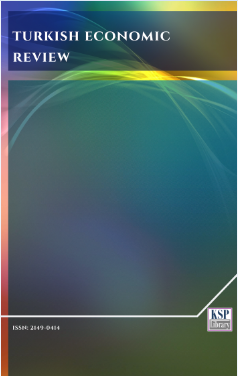Sukuk in the World and Turkey
Abstract
Abstract. As a result of globalization, the integration initiatives of the international financial markets cause various problems. Moreover, these problems are not only limited to the country in which they occur, but can also spread to other countries by snowball-effect or transmission. When we review the world financial history, countries have often experienced financial crises in recent years. At the same time, they have developed various methods to eliminate or reduce the negative effects of crises. Sukuk issues made in a country change the effects of the financial crisis that country is exposed to. This is mainly because of the fact that the Sukuk instruments are insensitive to interest. In this paper, the case study method has been adopted. In accordance with this method, it is intended to make an assessment of the sukuk applications in the world and in Turkey.
Keywords. Sukuk, Capital movements, Global financial crisis.
JEL. G10, G15, G20, G21.Keywords
References
Ahmad, W., & Radzi M.R. (2011). Sustainability of sukuk and conventional bonds during financial crisis: Malaysian capital market. Global Economy and Financial Journal, 4(2), 33-45.
Alasrag, H. (2009). Global financial crisis and Islamic finance, Accessd on: Dec.10, 2020. [Retrieved from].
Alpaslan, H.İ. (2014). Sukuk, as a new financial instrument (lease certificates) and sukuk accounting, Financial Research and Studies Journal, 6(11), 15-31. doi. 10.14784/JFRS.2014117325
Ayub, M. (2007). Understanding Islamic Finance, John Wiley and Sons, West Sussex.
Büyükakın, F., & Bilal, E. (2016). An evaluation on the sukuk applications in financial crises, Journal of Financial Researches and Studies, 8(14), 33-55. doi. 10.14784/jfrs.21594
Büyükakın, F., & Önyılmaz, O. (2012 ). Interest-free bonds and sukuk: Turkey applications, Journal of Financial Research and Studies, 4(7), 1-16.
Cansen, E. (2002). Capital Movements, [Retrieved from].
Deeg, R., & O’Sullivan, M. (2009). The political economy of global finance capital, World Politics, 61(4), 731-763. doi. 10.1017/S0043887109990116
Delice, G. (2003). Financial crises: A theoretical and historical perspective, Erciyes University Journal of the Faculty of Economics and Administrative Sciences, 20, 57-81.
Fadel, M. (2008). Riba, efficiency and prudential regulation, Wisconsin International Law Journal, 25(4), 655-704.
Feroz, E. H. (2009). Wrongs to rights: The global financial crisis offers an opportunity to lay the foundation for an equitable and sustainable economic and social order. Islamic Horizons, pp. 22-24. [Retrieved from].
Farooq, M.O. (2009). Global financial crisis and the link between the monetary and real sector: Moving beyond the asset backed Islamic finance, Bahrain Royal University for Women, No.2-3.
Fırat, E., & Kurtoğlu, R. (2014). Finans dünyasının krizler karşısındaki belirsizliği davranışsal ekonomi, Aksaray Üniversitesi İktisadi ve İdari Bilimler Fakültesi Dergisi, 7(1), 87-101.
Hussin, M.Y., Muhammad, F., & Awang, S.A. (2012). Development of sukukijarah in Malaysia. Journal of Islamic Economics, Banking and Finance, 8(2), 91-102.
International Islamic Financial Market (IIFM), (2011). Sukuk Report 1st Edition. Accessed on: Nov.15, 2020. [Retrieved from].
International Islamic Financial Market (IIFM), (2018). Annual Sukuk Report 2018, 7th Edition. Accessed on: Nov.15, 2020. [Retrieved from].
International Islamic Financial Market (IIFM), (2020). IIFM Sukuk Report 2020, 9th Edition. Accessed on: Dec. 01. 2020. [Retrieved from].
İnandım, Ş. (2005). Short-term capital movements and real exchange rate interaction: The case of Turkey, Central Bank of the Republic of Turkey, Specialist Thesis. [Retrieved from].
Koç, A.G. (2018). Impact of hot money flows and speculation within the framework of international capital movements in Turkey, Journal of International Humanities Science and Education, 4(7), 184-207.
Mishkin, F.S. (2001). Financial policies and the prevention of financial crises in emerging market countries, NBER Working Paper Series, No.8087. doi. 10.3386/w8087
OsservatoreVatican, (2009). Islamic Banking May Help OvercomeCrisis. Press Release.
Palley, T. I. (2007). Financialization: What it is and why it matters. Levy Economics Institute Working Paper, No.525. [Retrieved from].
Sawyer, M. (2013). What Is Financialization?, International Journal of Political Economy, 42(4), 5-18, doi. 10.2753/IJP0891-1916420401
TKBB, (2020). Accessed on Dec. 01. 2020. [Retrieved from].
Ulus, S. (2013). Fixed income investment (Sukuk) in Islamic finance, Afro Eurasian Studies, 2(1-2), 28-305.
Ulusoy, A., & Ela, M. (2016). Sukukun ikinci el piyasa sorunu. Hukuk ve İktisat Araştırmaları Dergisi, 8(1), 55-70.
Yeldan, E. (2016). Turkish Economy in the Globalization Process, Distribution, Accumulation and Growth, 17th Edition, İstanbul: İletişim Press.DOI: http://dx.doi.org/10.1453/ter.v7i4.2159
Refbacks
- There are currently no refbacks.
.......................................................................................................................................................................................................................................................................................................................................
Turkish Economic Review - Turk. Econ. Rev. - TER - www.kspjournals.org
ISSN: 2149-0414
Editor: [email protected] Secretarial: [email protected] Istanbul - Turkey.
Copyright © KSP Library




